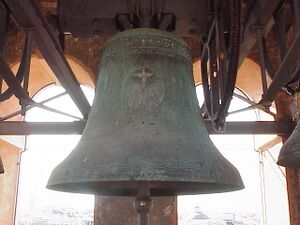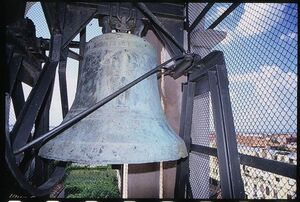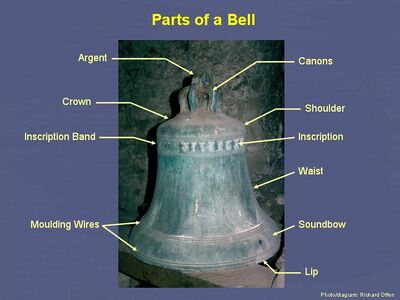Bell: Difference between revisions
Created page with "''This page is a description of a typical Venetian bell. For an overview of all the bells in Venice, see Bells.'' ''This section needs improvement.'' A Venetian bell, kno..." |
No edit summary |
||
| Line 1: | Line 1: | ||
''This page is a description of a typical Venetian bell. For an overview of all the bells in Venice, see [[Bells]].'' | ''This page is a description of a typical Venetian bell. For an overview of all the bells in Venice, see [[Bells]].'' | ||
A Venetian bell, known in Italian as ''campana'', has had many different uses. Before modern times, bells had more purpose than pure musical entertainment. They were signals of danger, disaster, and alarm. Many bells of today were built in medieval times, and were manufactured using a specific set of techniques and materials. | A Venetian bell, known in Italian as ''campana'', has had many different uses. Before modern times, bells had more purpose than pure musical entertainment. They were signals of danger, disaster, and alarm. Many bells of today were built in medieval times, and were manufactured using a specific set of techniques and materials. | ||
==Bell Construction== | ==Bell Construction== | ||
The casting of bells is a delicate and precise process. The style of a particular bell depends upon the foundry in which it was made, along with the materials that compose it and the period of its creation. | The casting of bells is a delicate and precise process. The style of a particular bell depends upon the foundry in which it was made, along with the materials that compose it and the period of its creation. | ||
| Line 46: | Line 44: | ||
==See Also== | ==See Also== | ||
[[Bells]] | *[[Bells]] | ||
[[Bell Ringing]] | *[[Bell Ringing]] | ||
[[Bell Tower]] | *[[Bell Tower]] | ||
[[Bell Towers]] | *[[Bell Towers]] | ||
==References== | ==References== | ||
Revision as of 15:57, 16 June 2014
This page is a description of a typical Venetian bell. For an overview of all the bells in Venice, see Bells.
A Venetian bell, known in Italian as campana, has had many different uses. Before modern times, bells had more purpose than pure musical entertainment. They were signals of danger, disaster, and alarm. Many bells of today were built in medieval times, and were manufactured using a specific set of techniques and materials.
Bell Construction
The casting of bells is a delicate and precise process. The style of a particular bell depends upon the foundry in which it was made, along with the materials that compose it and the period of its creation.
Material of Bells
The most common material for bells is bronze, an alloy of copper and tin. Very rarely bells were cast in steel and cast iron. This shift in bell materials occurred mainly during times of war, when alloys such as bronze were in short supply since copper was needed in the manufacturing of some weapons. Around 1857 A.D. a combination of iron and carbon, also known as steel, became a material for bell-making. Not soon after it had begun being used it was discarded since the compound was deemed unsuitable for a material of bells.
Bell Casting and Founding
Bells have typically been made using the same process for over six centuries. A popular method of bell casting is to use sand-casting. In medieval times, when many bells were being produced, molds were made from clay to make a template for the bells. A bell mold had a center mold and an outer mold, where molten bronze was poured between the two and then allowed to cool to take the shape of a bell. Back in the middle ages, sometimes wooden templates were also used. Through the use of these templates the distinctive shape of the bells was formed.
For more information about bell founding, see external_LINK.
Bell Frame Design
Two bell frame types are primarily used to suspend bells, the H frame and the A frame. The H frame occurs when the bell is suspended on a cross bar made of heavy H castings usually composed of a durable metal material such as cast iron. The metal material resists twisting and provides a secure base for the bell. The popularity of this type of design resides in its greater convenience and construction.
Example of an H Frame:

Example of an A Frame:

Anatomy of a Bell
All church bells have similar features. There is the crown, in which the vibrations mostly come from and the shoulder, which is the curvature at the top. The part that induces the sound, in most cases, is the clapper which is the long piece that hangs from the top of the inside of the bell. When rung it hits the strike point, or soundbow, of the bell.
For more information on bell ringing, see Bell

Bell Decoration
When ancient bells were cast, the moldings and decor on them were treated as a form of art. The inscriptions, figures, and design on each bell were well thought out by the founder and were intended to be a reflection of the founders work.
Most European bells are similar in their decorations, which usually include an inscription about where or when they were made or an engraving of a religious figure. Another trend founders have implemented was to design a trademark with a symbol or initials instead of writing out the full name of the founder.
Historical figures are a common form of art found on bells. These include effigies of saints, angels, or royal leaders. In addition, one may find the shield of the patron who invested in the tower or church. However, the most frequently used decor were inscriptions which offer information of whom the bell was dedicated to, who the maker or donor was, when it was cast, and other supplemental information. These are typically in Latin, although some may be in the native Italian.
IMAGES with examples
Bronze Corrosion
Most of the bells in Venice, being made of bronze, suffer from a cyclic degrading process known as Bronze disease. The disease refers to a chemical process in which the copper in bronze reacts with elements and moisture in the atmosphere creating a film signifying corrosion. Bell towers provide perfect conditions for bronze disease to propagate by leaving bells exposed to environmental conditions such as humidity, high winds, rain, and moisture. The thick green coating has the ability to transform the object by corroding the surface and possibly removing valuable artwork from its face. Many of the bells have intricate images exuding from their surfaces making corrosion a significant problem.
For more information on bronze corrosion, see external_LINK.
See Also
References